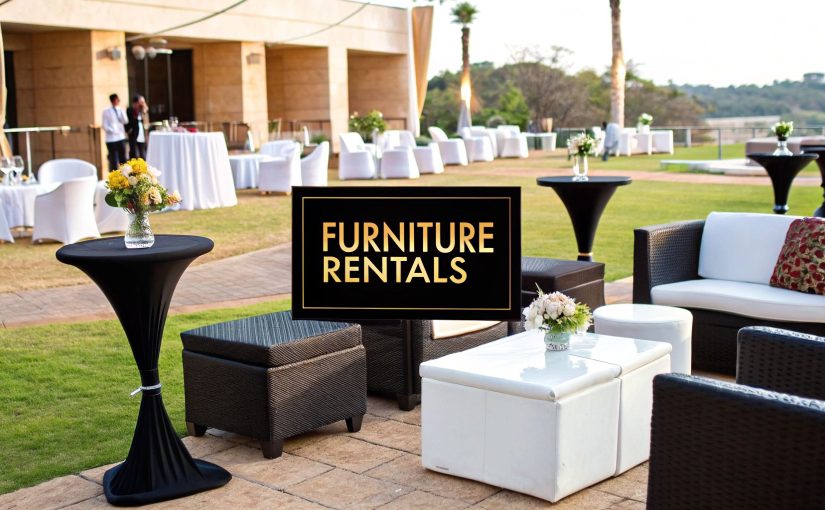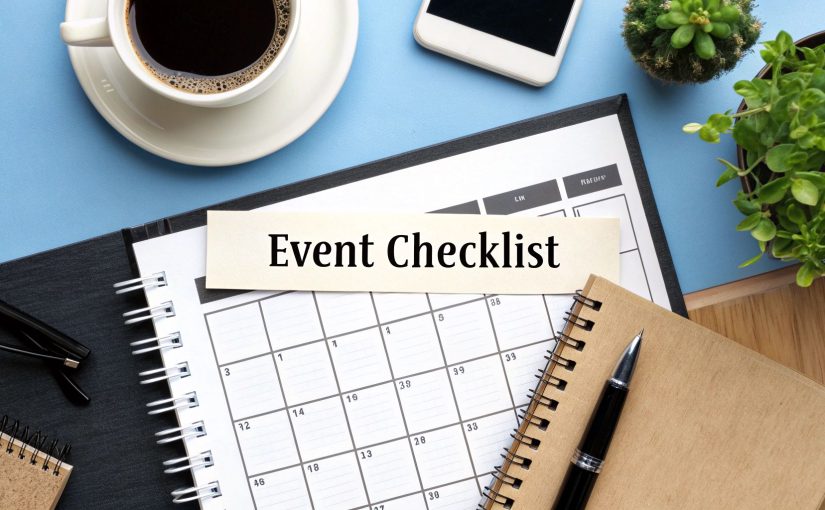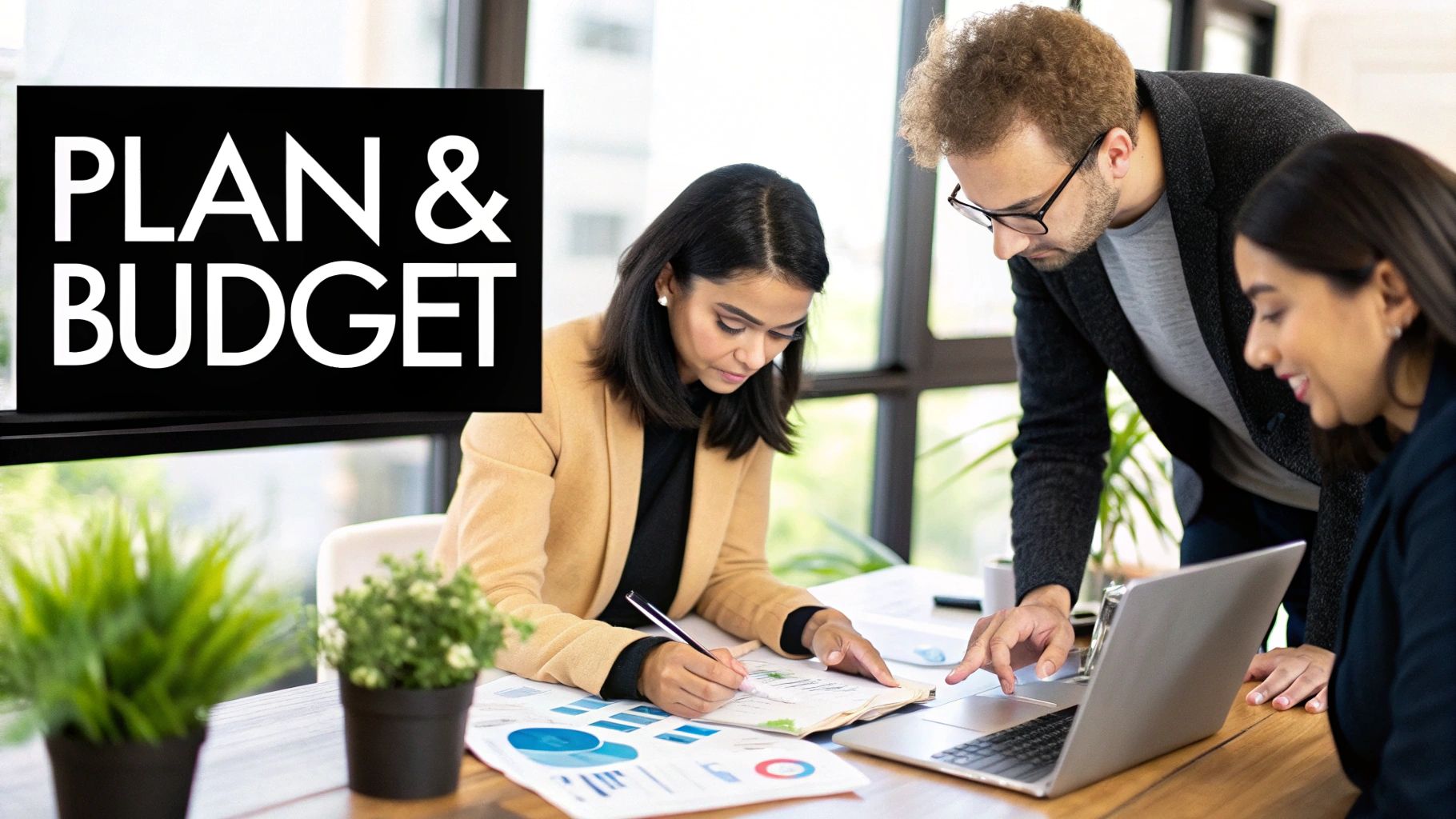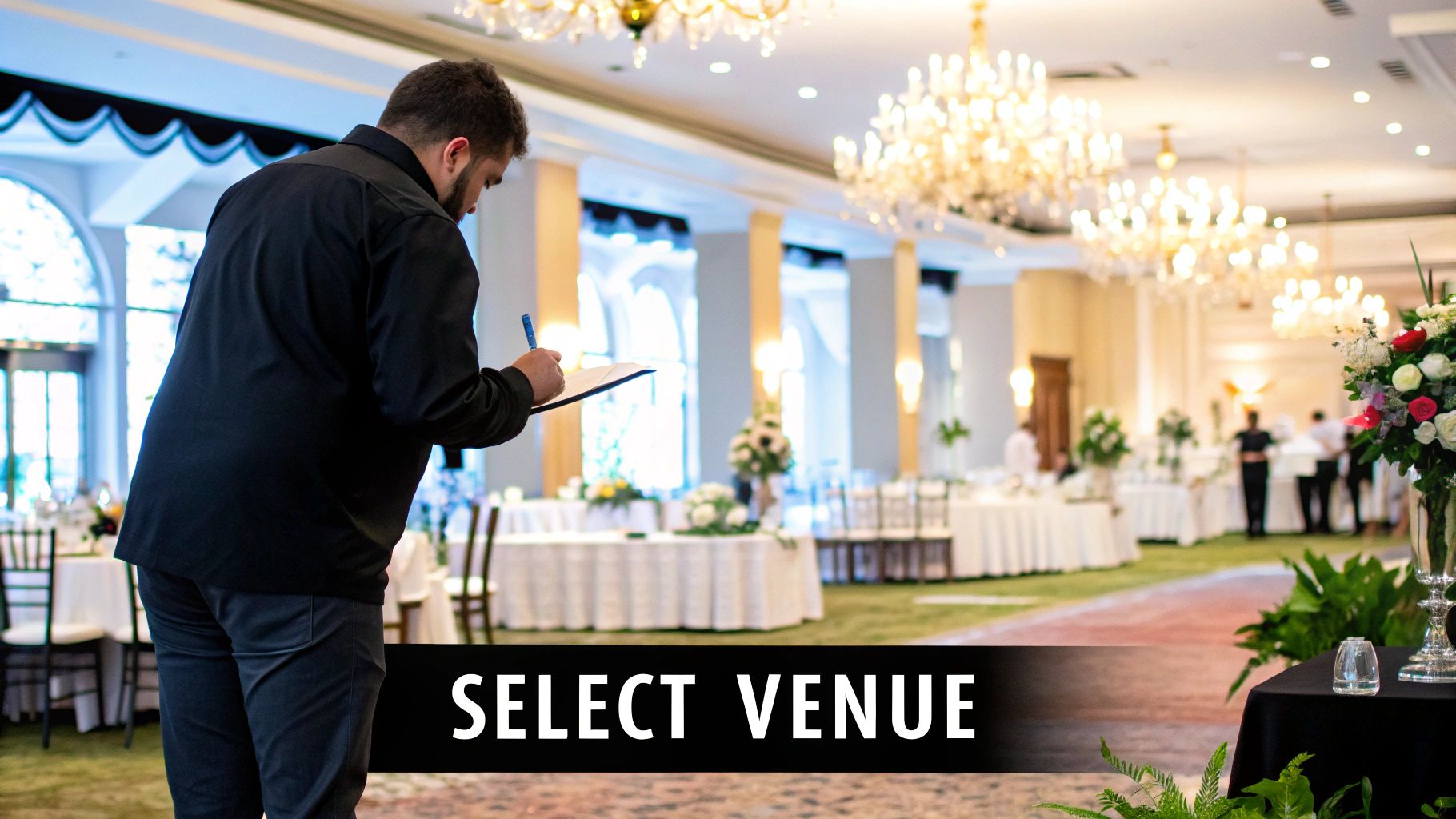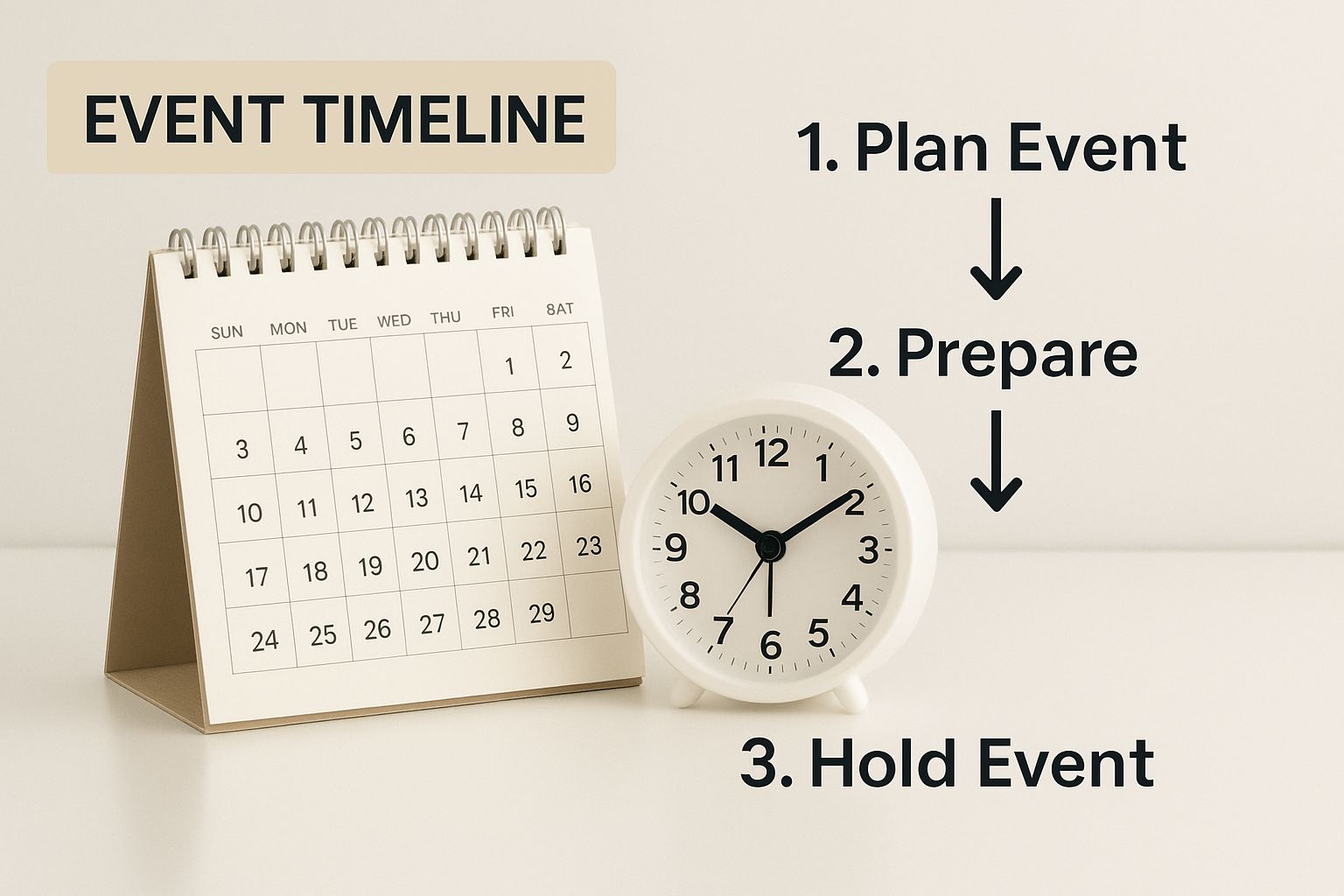Renting furniture for an event is your secret weapon for crafting the perfect atmosphere and a smart, functional layout without blowing your budget on a massive capital investment. It’s all about hand-picking the right chairs, tables, and lounge pieces, then coordinating the delivery and setup to bring your vision to life. This process is key to making sure your venue is not just filled, but perfectly tailored to your guests' comfort and your event's unique goals.
Laying the Foundation for a Flawless Event
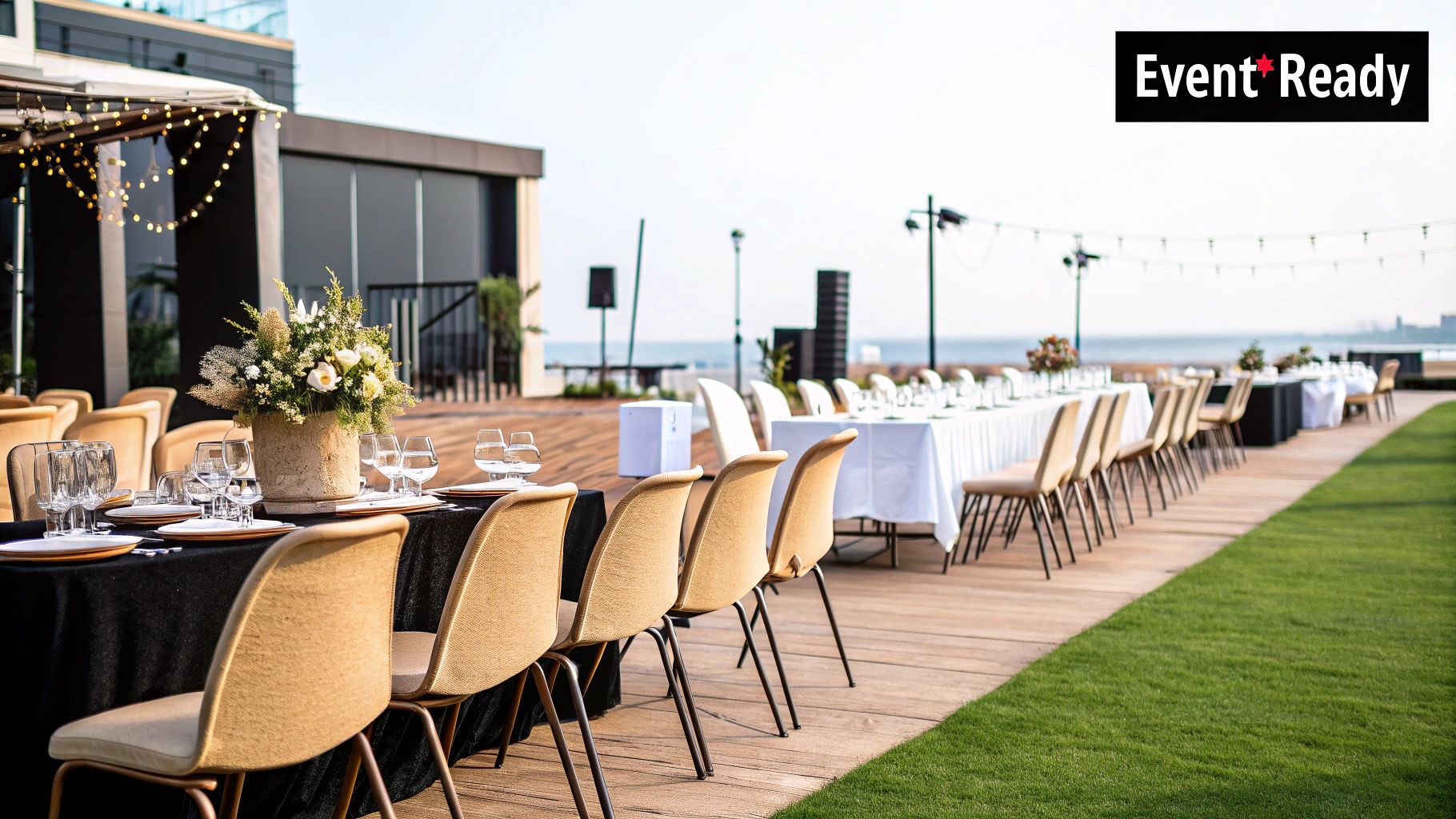
Before you even think about flicking through catalogues and falling in love with a particular style, there's a crucial first step: building a detailed furniture inventory. This isn't just about counting heads. It's about mapping out the entire journey your attendees will take, from the moment they walk in to the moment they leave. You need to consider every single touchpoint.
Think about the flow. What’s the very first impression? A slick registration area might need some sleek counters or a few high-top tables for those first quick chats. For a corporate conference in Sandton, for example, this sets a sharp, professional tone right from the get-go.
Mapping Out Your Functional Zones
The best way to tackle this is to break your venue down into distinct functional zones. Each area has a specific job to do, which means it needs its own specific furniture. When you organise your plan this way, you make it almost impossible to forget those critical items that can make or break the guest experience.
Think about the common zones you might have:
- Registration Area: This could mean high counters for a smooth check-in, maybe some small tables for welcome drinks, and even some soft seating for guests who arrive a bit early.
- Main Session Space: Are you picturing theatre-style seating for a big presentation, or elegant round tables for a gala dinner? The choice you make here completely changes how people interact.
- Networking or Breakout Zones: This is where you can encourage people to connect. Comfortable lounge furniture—think sofas and armchairs grouped around coffee tables—works wonders. For a wedding in the Cape Winelands, this kind of setup creates a wonderfully relaxed and intimate vibe.
- Catering and Bar Areas: You'll need practical pieces here. Bar leaners, cocktail tables, and enough bar counters are non-negotiable for keeping service smooth and guests moving freely.
A well-planned furniture layout does more than just fill a room. It directs foot traffic, sparks conversation, and sets the entire mood of the event. Don't just plan for seating—plan for movement.
Creating Your Initial Inventory List
Once you’ve mapped out your zones, you can start building a preliminary inventory list. And I mean specific. Don't just write "chairs." Write "150 white folding chairs for the ceremony" and "15 comfy lounge chairs for the relaxation zone." Getting this level of detail down is absolutely vital when you start asking for quotes.
This whole process of planning for renting furniture for events ensures nothing slips through the cracks. It turns that big idea in your head into a solid, actionable plan that rental companies can give you an accurate quote for. Remember, you’re not just hiring furniture; you're strategically designing an entire experience. Putting in this foundational work makes every step that follows—from budgeting to styling—so much easier and more effective.
Defining Your Event Style and Atmosphere
Right, you’ve got your inventory list sorted. Now we can move from the purely practical to the fun, creative part. The furniture you choose is so much more than just a place for people to sit; it’s a storyteller, an atmosphere-creator. This is your chance to really dial up your event’s theme and brand identity, turning functional items into powerful mood-setters.
The whole point is to create a cohesive look that feels deliberate and well-thought-out. Planning a sleek, modern corporate gala in Sandton? You'll be looking at minimalist furniture with clean lines, maybe some metallic accents, and a cool, monochromatic colour scheme. On the other hand, a rustic wedding out in Stellenbosch calls for something completely different – think natural wood tables, classic cross-back chairs, and soft, earthy tones.
Curating a Cohesive Look
Pulling together the right colours, textures, and materials is what will give your event that polished, professional feel. Don't be shy about mixing and matching, but always do it with a clear vision in mind. A plush velvet sofa can add an unexpected touch of luxury to an industrial venue, while rattan chairs can bring a relaxed, bohemian vibe to a formal garden party.
I always recommend starting with a mood board. Pull together images that capture the exact feeling you’re trying to create. This visual guide is a lifesaver, keeping you and your rental company on the same page and ensuring every single piece contributes to the overall design.
- Colour Palette: Stick to two or three main colours, then bring in accent shades to add a bit of depth.
- Material Mix: Play around with different materials. Combining wood, metal, glass, and fabric creates a much more interesting space.
- Texture: Think about how things feel. From smooth leather to plush velvet or rough-hewn wood, varied textures make a space feel more dynamic and engaging.
The market for renting furniture for events is shifting. We're seeing that roughly 40% of South African renters are now looking for brand-customised or stylistically unique furniture. It’s not just about a chair anymore; it's about the right chair. Sustainability is also huge, with nearly half of all our corporate clients requesting pieces made from eco-conscious materials. It's a clear reflection of a wider global trend.
The Power of Statement Pieces
While a cohesive design is your foundation, don't forget about the massive impact of a few standout items. A unique "statement piece" can act as a focal point for a room and, cleverly, an organic marketing opportunity. We're talking about an ornate vintage armchair, a custom-branded bar, or a set of those incredible glowing LED cocktail tables.
These aren't just pieces of furniture; they're 'Instagrammable' moments waiting to happen. A well-chosen statement piece encourages guests to take photos and share their experience, generating valuable buzz for your event long after it's over.
For example, a branded media wall with some stylish seating in front of it will instantly become the go-to spot for photos. In a networking area, distinctive bar tables and chairs can do more than just provide seating; they become conversation starters. You can see what I mean by exploring the stylish options in our guide to hiring bar tables and chairs.
Ultimately, your furniture choices should feel like a seamless extension of your event's identity. You're not just filling a space; you're creating an environment that’s not only beautiful but truly memorable for every single guest.
Smart Budgeting for Your Furniture Rental
A realistic budget is the backbone of any successful event. When it comes to renting furniture for events, knowing all the potential costs upfront is the difference between a smooth process and a stressful surprise. Trust me, you need to look beyond the simple per-item price tag to create a financial plan that actually works.
Your quote will include more than just the chairs and tables. You have to account for several line items that are essential for a seamless experience. These usually include delivery and collection fees, labour for setup and breakdown, and sometimes a damage waiver to protect against those little accidents.
Deconstructing Your Rental Quote
When a quote lands in your inbox, don't just skim to the total at the bottom. Break it down. You need to understand exactly what you're paying for. This transparency is key for comparing different suppliers fairly and making sure there are no nasty hidden fees waiting for you later on.
A clear, professional quote should always detail:
- Per-Item Costs: The price for each individual piece you’ve chosen.
- Delivery and Collection Fees: This often changes based on how far your venue is from their warehouse.
- Labour Charges: The cost for the crew to set up and break down everything according to your floor plan.
- Damage Waiver: An optional but highly recommended fee—usually a small percentage of the total—that covers accidental damage.
- VAT: Always check if the prices are inclusive or exclusive of VAT.
The local market here is more professional than ever. Since the early 2010s, the South African event furniture rental sector has blossomed from a handful of small operators into a mature industry valued in the hundreds of millions of rands. If you're interested in the numbers, you can explore more data on the party and furniture rental industry's market growth.
Pro Tip: Always, always ask for an itemised quote. This gives you the power to make strategic cuts if you need to. For example, you might decide to swap out premium chairs for a more budget-friendly option to free up cash for a stunning statement lounge area.
Sample Budget Scenarios
To really see this in action, let's look at how costs can vary. The biggest factor that will influence your furniture rental budget is, without a doubt, the scale of your event.
This gives you a good idea of how to pick furniture that fits your event's style and your budget.
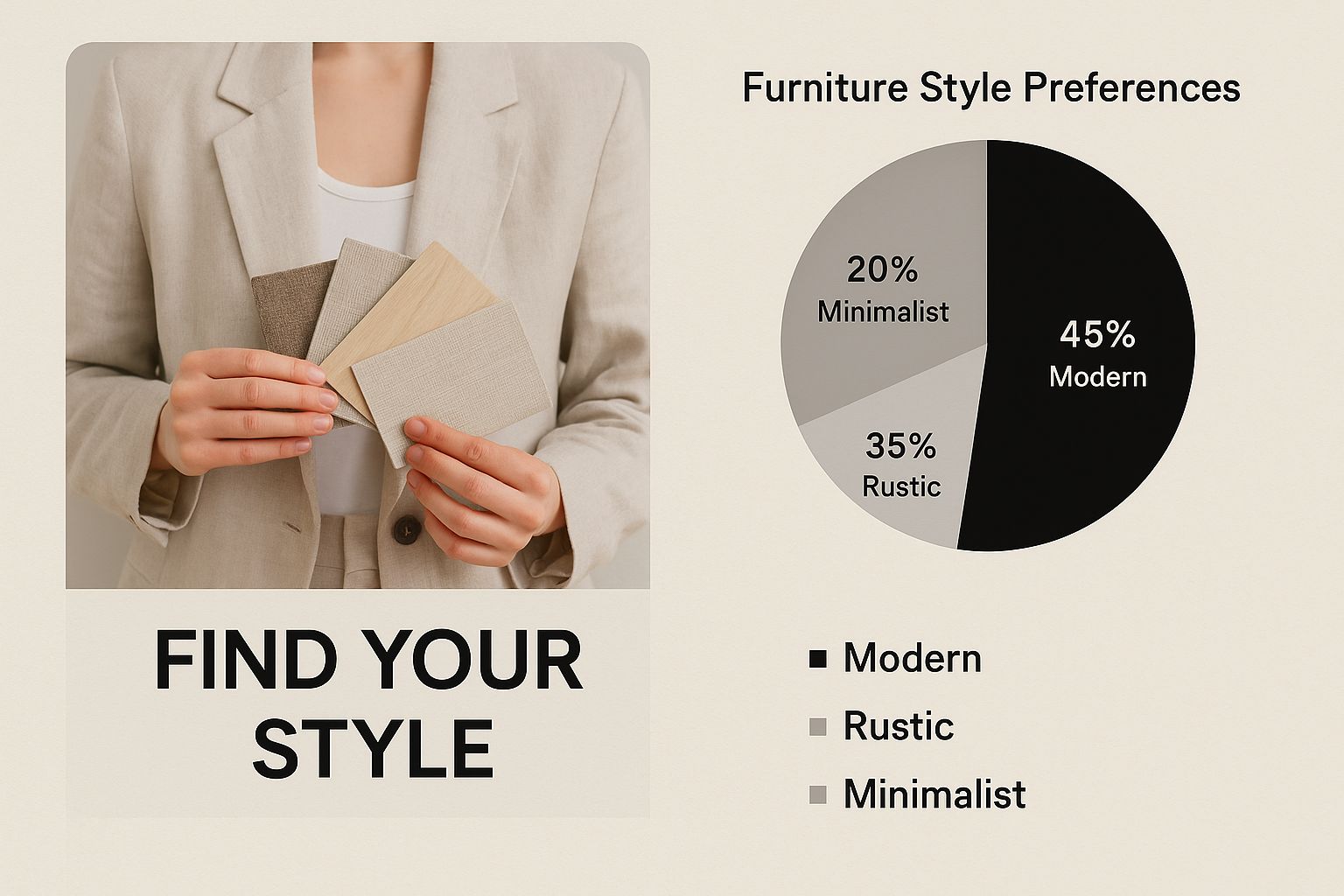
It’s all about balancing those aesthetic dreams with practical financial decisions to bring your vision to life.
Let’s compare two common event types in South Africa to see how the numbers might look. Just remember, these are estimates and will change based on your specific choices and supplier.
Here's a sample breakdown to give you a clearer picture.
Sample Furniture Rental Budget Breakdown
| Cost Item | Corporate Workshop (50 Guests) | Wedding Reception (150 Guests) |
|---|---|---|
| Seating (Chairs) | R2,500 | R9,000 |
| Tables (Work & Dining) | R3,000 | R12,000 |
| Lounge Pod (Sofas, Chairs) | R4,500 | R15,000 |
| Cocktail & Bar Furniture | R2,000 | R7,500 |
| Delivery & Collection | R1,200 | R2,500 |
| Labour (Setup/Breakdown) | R1,500 | R4,000 |
| Estimated Subtotal | R14,700 | R50,000 |
| Damage Waiver (10%) | R1,470 | R5,000 |
| Estimated Grand Total | R16,170 | R55,000 |
As you can see, the costs scale up significantly with guest count and complexity.
By planning your budget with this level of detail, you can allocate funds with confidence. You’ll be able to strike that perfect balance between your creative vision and financial reality, ensuring your event looks absolutely fantastic without any last-minute money worries.
Choosing the Right Rental Partner in South Africa
Okay, you’ve got your budget locked in. Now comes the big one: finding the right team to supply your event furniture. This isn't just about ticking items off a list. The company you pick can make or break your event, and a bad choice can quickly turn your big day into a logistical nightmare.
Think of it this way: your rental partner is an extension of your own team. Their job is to deliver, but the great ones do so much more. Your first step should be to look past the glossy website photos and dig a little deeper. Do they actually have the specific styles you want, and in the right quantities? A company with a deep and varied inventory is usually a good sign they know what they're doing.
Evaluating Potential Suppliers
Before you start firing off quote requests, take a moment to do some homework. The South African event scene is buzzing, which is great because you have options. But it also means you need to be smart about who you trust. You're looking for a partner who is professional, reliable, and has the track record to prove it.
A brilliant starting point is to check out recent client reviews. Don't just skim them—look for comments that go beyond the quality of the furniture itself. What are people saying about their communication? Their punctuality? The professionalism of the setup crew? These are the details that truly matter when the pressure is on.
- Check their service area: Make sure they actually deliver to your venue, whether you’re in the heart of Johannesburg or a remote spot in the Winelands.
- Assess their inventory quality: If you can, ask to see the items in person at their showroom or warehouse. This is the only way to get a true feel for the condition of their stock.
- Read online reviews: Dive into Google, social media, and any local event forums to find honest, unfiltered feedback from past clients.
It's worth noting that the market is heavily concentrated in the major cities. In South Africa, around 70% of furniture rental companies are based in Johannesburg, Cape Town, and Durban, and large event firms drive about 60% of the demand. So, if your event is in a major hub, you’ll have your pick of top-tier suppliers. For a closer look, you can explore insights on the South African event furniture market.
Key Questions to Ask Potential Partners
Once you've shortlisted a few promising companies, it’s time to get in touch. The goal here is simple: to understand their process and see if it clicks with your needs. Don't hold back on asking detailed questions. A seasoned, confident company will have clear, straightforward answers ready to go.
You need to cover the nuts and bolts of logistics, on-the-day support, and what their backup plan is if things go sideways. Treat it like you're interviewing a crucial new team member, because that's exactly what you're doing.
A reliable rental partner is more than just a supplier; they are your logistical backbone on event day. Their ability to handle pressure, solve problems, and communicate clearly is just as important as the quality of their chairs.
Here are a few non-negotiable questions to get the conversation started:
- What’s your standard process for delivery and collection? How much wiggle room is there on timings?
- Will we have a dedicated contact person on-site during setup?
- What’s your Plan B for a crisis, like damaged furniture or a delayed truck?
- Can you walk me through your cancellation policy and payment terms?
Asking these upfront helps you gauge their professionalism and makes sure everyone is on the same page. It’s all about building confidence that your vision will be executed flawlessly. This is especially true if you’re trying to source specific items, like chairs for a big wedding. If that’s you, our guide on how to find the best chairs for hire near you offers some extra pointers.
Getting the On-the-Day Logistics Spot On
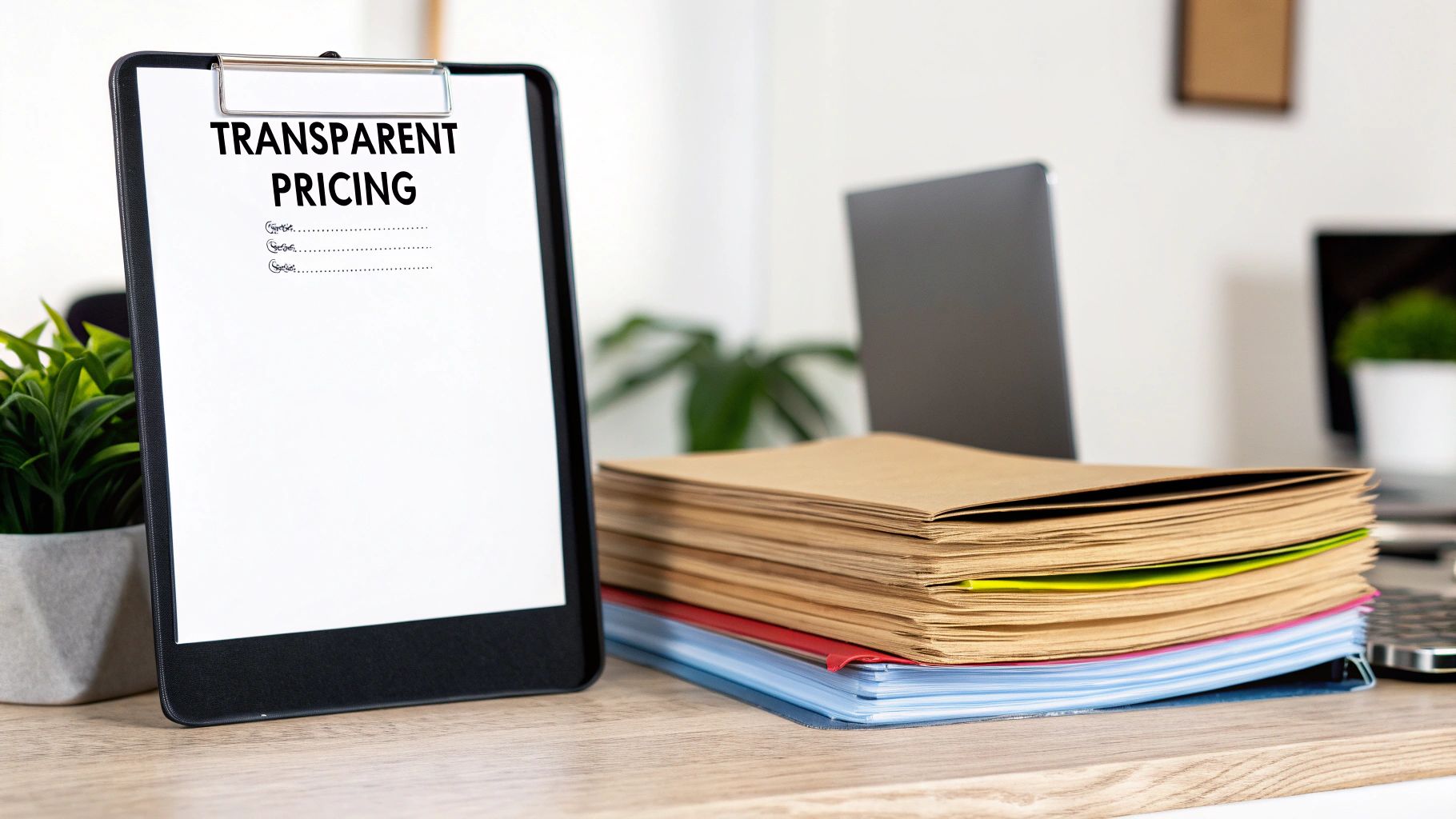
Even the most stunning furniture is no good if it doesn't show up on time and in perfect nick. This is where getting your event day logistics right becomes your most important job. Nailing the coordination between your venue and your rental company is the secret to a smooth, stress-free setup.
Success on the day really just comes down to clear communication and planning every last detail. You absolutely cannot leave things to chance when you're renting furniture for events. It all starts way before the delivery truck even thinks about pulling up.
Your Delivery and Setup Game Plan
First things first, you need a detailed floor plan. I don't mean a quick sketch on a napkin; this needs to be a proper map showing exactly where every single table, chair, and lounge pod is meant to live. Get this plan to both your venue manager and your rental company well ahead of time.
Next, get a firm schedule locked in. Don't just agree on a delivery "day"—be specific. Pin down a precise delivery window and a collection time that works for everyone involved. This is how you avoid chaos with other suppliers and make sure the venue is actually ready for you.
A massive part of this is confirming access. You have to check:
- Loading Bay Access: Where can the truck park? Are there any sneaky height or time restrictions?
- The Route In: Will the crew be using a service lift or specific corridors? Is the path clear of any junk or obstacles?
- Who's in Charge: Who is the on-site contact person the delivery team should find when they arrive?
Nailing the On-Site Setup
When the big day arrives, that clear communication becomes everything. Make sure you have one person designated to meet the delivery crew. This person will be in charge of directing the setup based on your floor plan and sorting out any questions on the spot.
Once all the furniture is in place, it’s time for a final walkthrough. This is your last chance to inspect everything before your guests start arriving. Look for any scuffs, wobbly legs, or items in the wrong spot. It's so much easier to fix a small problem an hour before the event than right in the middle of it.
If you're going for a more relaxed vibe, casual seating is brilliant, but even that needs a plan. For things like bean bags in a chill-out zone, our guide to Cape Town bean bag hire has some great tips on how to fit them into your layout perfectly.
The success of your event setup hinges on the details you confirm beforehand. A ten-minute call to coordinate access points and timings can save you hours of stress and confusion on the day.
Finally, don't forget to confirm the breakdown process. Your rental company needs to know exactly when they can come back to collect everything. A seamless pack-down is just as important as the setup; it ensures you leave the venue looking great and stay on good terms with the management. A solid logistical plan is truly the final, crucial piece of the puzzle for a perfectly run event.
Your Event Furniture Rental Questions, Answered
When you’re deep in planning mode, a few questions about furniture rental always seem to pop up. To make sure you feel completely in control, we've pulled together some of the most common queries we get from event planners across South Africa and laid out the answers, plain and simple.
How Far in Advance Should I Book My Furniture?
For the best possible selection, you’ll want to book your furniture 3-6 months in advance. This is especially true if your event is during a busy time, like the summer wedding season or the year-end function rush. The most sought-after pieces from top suppliers in hubs like Cape Town and Johannesburg get snapped up fast.
If you're planning a really big event or have your heart set on some custom-made items, giving yourself 6-12 months is an even better idea. This gives everyone enough breathing room to get the details perfect, avoiding that last-minute panic.
What Happens If Something Gets Damaged?
Let's be realistic—accidents happen. Your rental agreement will almost certainly state that you're responsible for the cost of repairing or replacing anything that gets broken. This is exactly why a damage waiver is so important.
Most rental companies offer one for a small fee, usually a percentage of your total hire cost. It's designed to cover accidental damage, but it won't cover damage from obvious carelessness.
Always take a few minutes to properly read the liability clause in your contract. Knowing what you're responsible for before you sign is the best way to protect your budget and avoid any nasty surprises later.
Can I Hire Furniture for an Outdoor Event?
Of course! Many of our favourite suppliers have incredible ranges built specifically for outdoor use. That said, you absolutely need a backup plan for South Africa’s notoriously unpredictable weather. Think a marquee, a stretch tent, or an indoor space you can quickly move to.
Your contract will always make it clear that it's your job to protect the furniture from the elements. Rain and strong wind can cause serious damage and lead to extra charges, so a solid plan B ensures your event goes off without a hitch, no matter what the weather does.
Do Rental Companies Also Help with Design and Layout?
Many of the best full-service rental companies do. Their teams often have a wealth of design experience and can be a huge help with creating floor plans, choosing pieces that nail your theme, and making sure your guests can move around the space comfortably.
Some might include this as part of a package if you have a large order, while others may offer it as an add-on service. When you're chatting with potential suppliers, it's always smart to ask what kind of creative support they can give. Their experience can be the difference between a good event and an unforgettable one, and it's a key part of the value you get when renting furniture for events.
Ready to create an unforgettable atmosphere for your next event? The team at ABC Hire has the expertise and inventory to bring your vision to life. Explore our extensive range of stylish furniture and accessories at https://abchire.co.za and let's start planning.

